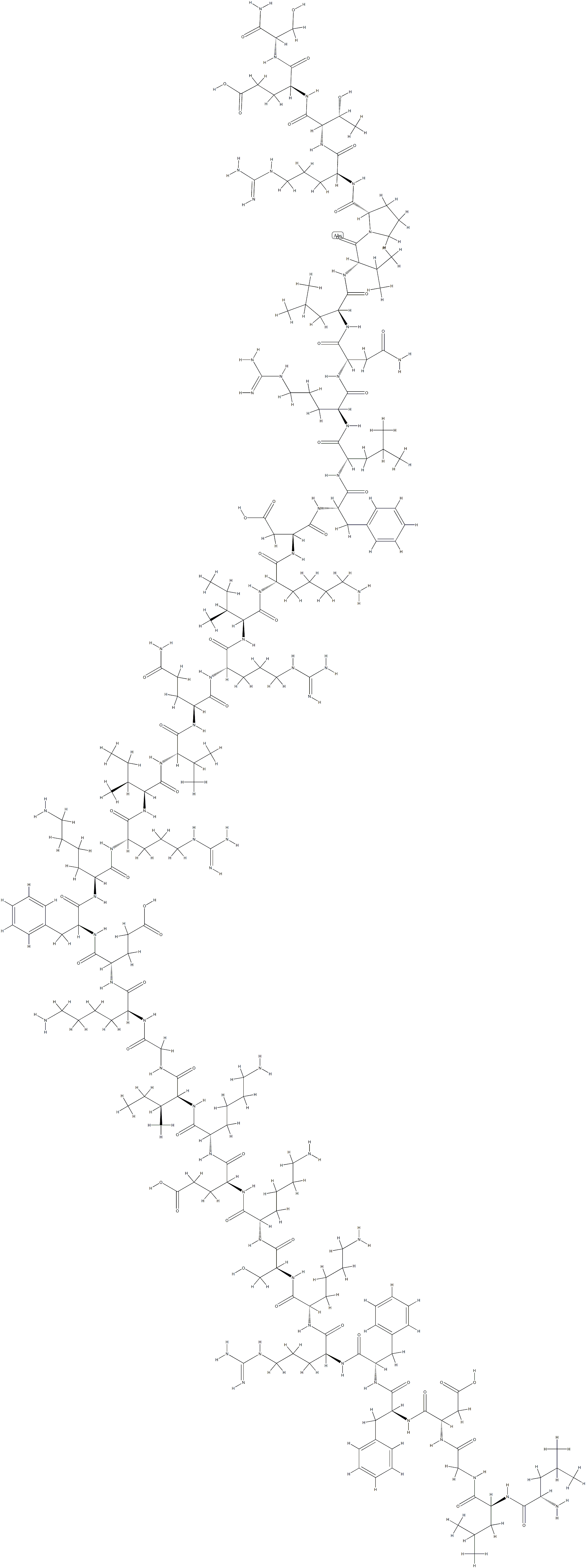antibacterial protein ll-37 amide (human)
Synonym(s):Anti-CAP18;Anti-cathelicidin antimicrobial peptide;Anti-Cationic antimicrobial protein;Anti-FALL39;Anti-FALL-39
- CAS NO.:597562-32-8
- Empirical Formula: C205H341N61O52
- Molecular Weight: 4492.27854
- MDL number: MFCD08460571
- EINECS: 200-001-8
- Update Date: 2024-11-19 23:02:33

What is antibacterial protein ll-37 amide (human)?
Description
LL-37, also known as hCAP18, belongs to the cathelicidins family of antimicrobial peptides that possess strong antimicrobial activity across multiple species. In humans, this is the only cathelicidin present, and it is produced in epithelial cells through the proteolytic cleavage of the hCAP-18 protein. In addition to its antimicrobial properties, LL-37 also plays a crucial role in regulating the immune system. It can inhibit inflammatory responses by suppressing the activation of TLR2 and TLR4, which recognize different components of bacterial cell walls.
Chemical properties
LL-37, a human antimicrobial peptide, is a white to off-white solid. This 37-residue peptide of cathelicidin origin is amphipathic and exhibits a broad spectrum of antimicrobial activity.
The Uses of antibacterial protein ll-37 amide (human)
LL-37 is a human antimicrobial peptide of the cathelicidin family and corresponds to the 134-170 segment of human cationic antimicrobial protein 18 (hCAP18). It plays an important role in the first line of defense against local infection and systemic invasion of pathogens at sites of inflammation and wounds. Cytotoxic to both bacterial and normal eukaryotic cells, LL-37 is significantly resistant to proteolytic degradation in solution.
Origin
LL-37 has been extensively studied since its discovery in 1995. This substance is a host defense peptide released by hCAP18 which is the only human cathelicidin.
Biological Functions
LL-37 has moderate antimicrobial activities against numerous Gram-negative and Gram-positive bacteria, including pathogens from the Pseudomonas, Escherichia, Staphylococcus, and Enterococcus genera. LL-37 is able to kill bacteria through direct antibacterial activities, as well as through immunomodulation. Like other AMPs, the primary mechanism of action is membrane disruption. The net positive charge of +6 allows for LL-37 to bind to the negatively charged membrane of bacteria. Upon binding, the introduction of transmembrane pores causes a disruption of cell integrity that leads to cell lysis and death. In addition, LL-37 is able to permeate the cell membrane in order to interact with intracellular targets, such as acyl carrier proteins. LL-37 has additional immunomodulatory properties, including both pro-inflammatory and anti-inflammatory responses, that are important for the indirect killing of bacteria For example, LL-37 is capable of inducing cell migration, proliferation and differentiation[5].
Biological Activity
The human cathelicidin HDP, LL-37, an amphipathic α-helical peptide, had a quite medium-sensitive antimicrobial activity and, unusually, the capacity to adopt this structure also in aqueous solutions at physiological salt concentrations. Most other helical AMPs only do so in the presence of biological membranes. It also had a significant capacity as a chemotactic agent for different types of immune cells, could stimulate release of pro-inflammatory chemokines and cytokines, could repress the effects of pathogen associated molecular patterns (PAMPs) such as LPS and LTA and could stimulate propagation of some cells involved in healing processes— it was a truly pleiotropic host defence peptide[6].
References
[1] Singh et al., (2014) LL-37 Peptide Enhancement of Signal Transduction by Toll-like Receptor 3 Is Regulated by pH. J. Biol. Chem. 289(40) 27614 PMID: 25092290.
[2] Tripathi et al., (2014) LL-37 modulates human neutrophil responses to influenza A virus. J. Leukoc. Biol. 96(5) 931 PMID: 25082153.
[3] Roth et al., (2020). LL-37 fights SARS-CoV-2: The Vitamin D-Inducible Peptide LL-37 Inhibits Binding of SARS-CoV-2 Spike Protein to its Cellular Receptor Angiotensin Converting Enzyme 2 In Vitro. [4] Preprint. doi: 10.1101/2020.12.02.408153
[5] Ridyard K, et al. The Potential of Human Peptide LL-37 as an Antimicrobial and Anti-Biofilm Agent. Antibiotics, 2021; 10: 650.
[6] Xhindoli D, et al. The human cathelicidin LL-37 — A pore-forming antibacterial peptide and host-cell modulator. Biochimica et Biophysica Acta (BBA) - Biomembranes, 2015; 1858: 546-566.
Properties of antibacterial protein ll-37 amide (human)
| storage temp. | -20°C |
| solubility | DMSO: Insoluble;Ethanol: 90 mg/mL (20.03 mM) |
| form | buffered aqueous solution |
| Water Solubility | Water: 90 mg/mL (20.03 mM) |
Safety information for antibacterial protein ll-37 amide (human)
Computed Descriptors for antibacterial protein ll-37 amide (human)
| InChIKey | JATXYCFPJFQHBQ-XAMSXPGMSA-N |
New Products
4-AMINO-TETRAHYDRO-PYRAN-4-CARBOXYLIC ACID HCL 4-(Dimethylamino)tetrahydro-2H-pyran-4-carbonitrile 4-AMINO-TETRAHYDRO-PYRAN-4-CARBOXYLIC ACID 4-Aminotetrahydropyran-4-carbonitrile Hydrochloride (R)-3-Aminobutanenitrile Hydrochloride 5-Bromo-2-nitropyridine Nimesulide BP Aceclofenac IP/BP/EP Diclofenac Sodium IP/BP/EP/USP Mefenamic Acid IP/BP/EP/USP Ornidazole IP Diclofenac Potassium 3-Bromopyrazole (3aR,4R,5R,6aS)-hexahydro-5-Triethyl silyloxy-4-((E)-3-oxo-5-phenylpent-1- enyl)cyclopenta[b]furan-2-one. 1-Chlorocarbonyl-4-piperidinopiperidine 1-Bromo-4-phenyl-2-Butanone 4-Amino-2-fluoro-N-methylbenzamide 1,1'-Carbonyldiimidazole SODIUM AAS SOLUTION ZINC AAS SOLUTION BUFFER SOLUTION PH 10.0(BORATE) GOOCH CRUCIBLE SINTERED AQUANIL 5 BERYLLIUM AAS SOLUTIONRelated products of tetrahydrofuran








You may like
-
 Anti-CAMP antibody produced in rabbit CASView Details
Anti-CAMP antibody produced in rabbit CASView Details -
 Anti-Cathelicidin antibody produced in rabbit CASView Details
Anti-Cathelicidin antibody produced in rabbit CASView Details -
![Dimethyl [2-oxo-3-[3-(trifluoromethyl)phenoxy]propyl]phosphonate 99%](https://img.chemicalbook.in//Content/image/CP5.jpg) Dimethyl [2-oxo-3-[3-(trifluoromethyl)phenoxy]propyl]phosphonate 99%View Details
Dimethyl [2-oxo-3-[3-(trifluoromethyl)phenoxy]propyl]phosphonate 99%View Details
54094-19-8 -
 85-81-4 99%View Details
85-81-4 99%View Details
85-81-4 -
![208111-98-2 (3aR,4R,5R,6aS)-5-(Benzoyloxy)hexahydro-4-[(1E)-3-oxo-4-[3-(trifluoromethyl)phenoxy]-1-buten- 1-yl]-2H-cyclopenta[b]furan-2-one 99%](https://img.chemicalbook.in//Content/image/CP5.jpg) 208111-98-2 (3aR,4R,5R,6aS)-5-(Benzoyloxy)hexahydro-4-[(1E)-3-oxo-4-[3-(trifluoromethyl)phenoxy]-1-buten- 1-yl]-2H-cyclopenta[b]furan-2-one 99%View Details
208111-98-2 (3aR,4R,5R,6aS)-5-(Benzoyloxy)hexahydro-4-[(1E)-3-oxo-4-[3-(trifluoromethyl)phenoxy]-1-buten- 1-yl]-2H-cyclopenta[b]furan-2-one 99%View Details
208111-98-2 -
 2033-24-1 99%View Details
2033-24-1 99%View Details
2033-24-1 -
 Meldrums acid 2033-24-1 99%View Details
Meldrums acid 2033-24-1 99%View Details
2033-24-1 -
 2-Aminopyridine 504-29-0 99%View Details
2-Aminopyridine 504-29-0 99%View Details
504-29-0